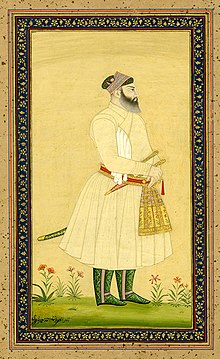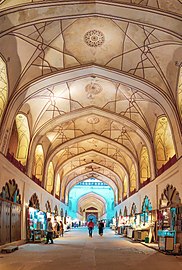This is an old revision of this page, as edited by Drmies (talk | contribs) at 23:07, 10 December 2024 (and why was that in the "Life" section). The present address (URL) is a permanent link to this revision, which may differ significantly from the current revision.
Revision as of 23:07, 10 December 2024 by Drmies (talk | contribs) (and why was that in the "Life" section)(diff) ← Previous revision | Latest revision (diff) | Newer revision → (diff) 17th century Mughal chief architect (1580-1649)
| UstadAhmad Lahori | |
|---|---|
 Miniature painting of Ustad Ahmad Mimar Lahori Miniature painting of Ustad Ahmad Mimar Lahori | |
| Born | c.1580 Lahore, Lahore Subah, Mughal Empire (modern-day Punjab, Pakistan) |
| Died | c.1649(1649-00-00) (aged 68–69) Delhi, Delhi Subah, Mughal Empire |
| Occupation | Architect |
| Buildings | Red Fort |
| Signature | |
 | |
Ustad Ahmad Lahori (c.1580–1649), also known as Ahmad Ma'mar Lahori, was a Mughal architect and engineer during the reign of Shah Jahan. He was responsible for the construction of several Mughal monuments, including the Red fort in Delhi, a World Heritage site.
His architecture is a combination of Indo-Islamic and Persian architectural styles, and thus, a major instance of Indo-Persian culture.
Life

Ustad Ahmad Lahori hailed from Lahore, Lahore Subah, as his nisba indicates. He has been described as a Punjabi Muslim or an Indian of Iranian heritage. Even after his family's migration to Delhi, his family is still referred to by the epithet "Lahori".
Ahmad Lahori hailed from a family of Timurid architects, originally from Herat. He was a skilled engineer who later in life was given the title of Nadir-ul-Asar ("wonder of the age") by Shah Jahan. Two of his three sons, Ataullah Rashidi and Lutfullah Muhandis, also became architects, as did some of his grandsons, Shah Kalim Allah Jahanabadi one among them. Ahmad Lahori was learned also in the arts of geometry, arithmetic and astronomy, and according to his son Lutfullah was familiar with the Euclid's Elements and Ptolemy's Almagest.
Career
In 1631, Shah Jahan appointed him for the construction of Taj Mahal. The construction project employed some 20,000 artisans under the guidance of a board of architects led by Ahmad Lahori. The project took twelve years to manifest into reality. Afterwards, he was relocated to Delhi where the emperor commissioned him for the construction of the new imperial city, Shahjahanabad, in 1639. The building of the city, including the Red Fort, was complete by 1648.
In writings by Lahori's son, Lutfullah Muhandis, two architects are mentioned by name: Ustad Ahmad Lahori and Mir Abd-ul Karim. Ustad Ahmad Lahori laid the foundations of the Red Fort at Delhi, which was built between 1638 and 1648. Mir Abd-ul Karim counted as the favourite architect of the previous emperor, Jahangir, and is mentioned as a supervisor, together with Makramat Khan, for the construction of the Taj Mahal.
- Ahmad Lahori's major works
-
 Red Fort's Lahori Gate in Delhi
Red Fort's Lahori Gate in Delhi
-
 Covered bazaar in Old Delhi
Covered bazaar in Old Delhi
See also
References
- Curl, James Stevens; Wilson, Susan (2015). The Oxford Dictionary of Architecture. Oxford University Press. p. 11. ISBN 978-0-19-967498-5.
- Balasubramaniam, R. (2009). "New insights on architects of Tāj". Indian Journal of History of Science, SpringerLink. 44 (3). National Institute of Sciences of India: 391. ISSN 2454-9991. OCLC 1398048453 – via University of California.
- Srivastava, Prof. R. P. (1981). "Patiala: Its Artistic and Cultural Significance". The Sikh Courier. 10 (4). London: Sikh Cultural Society of Great Britain: 16. ISSN 0037-511X. OCLC 265579842 – via University of Virginia.
Nadir-ul-Asar Ahmad Mimar Lahori Shahjehani was also a Punjabi who designed the Taj Mahal of Agra.
- Chopra, Ravindra Mohan (2005). Indo-Iranian Cultural Relations Through the Ages. Iran Society. p. 89. OCLC 85485369 – via University of Michigan.
- Janin, Hunt (2006). The Pursuit of Learning in the Islamic World, 610-2003. McFarland. p. 124. ISBN 978-0786429042. Retrieved 17 November 2021.
- Kanwar, H. I. S (1974). Pickthall, Marmaduke William; Asad, Muhammad (eds.). "Ustad Ahmed Lahori". Islamic Culture. 48. Islamic Culture Board: 11–32. ISSN 0021-1834.
- ^ Necipoğlu, Gülru (1 March 1996). The Topkapi Scroll: Geometry and Ornament in Islamic Architecture. Getty Publications. p. 155. ISBN 978-0-89236-335-3.
- Pingree, David, ed. (1970). Census of the Exact Sciences in Sanskrit Series A. Vol. 1. American Philosophical Society. p. 39.
- Dadlani, Chanchal (2016). "Innovation, Appropriation, and Representation: Mughal Architectural Ornament in the Eighteenth Century". In Gülru Necipoglu; Alina Payne (eds.). Histories of Ornament: From Global to Local. Princeton University Press. p. 183. ISBN 9780691167282.
- ^ Khan (Arshi), I. N. (28 August 2015). BLACK TAJ MAHAL: The Emperor's Missing Tomb. Black Taj Project. p. 38. ISBN 978-81-927479-0-3.
- Taj Mahal Description and Profile (Ahmad Lahori, architect of the emperor) UNESCO.org website, Retrieved 17 November 2021
- Begley and Desai (1989), p.65
- ^ Asher, p.212
Notes
|